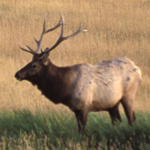|
HOME --> CLASS MAMMALIA
--> ORDER RODENTIA
--> SUBORDER SCIUROMORPHA
--> FAMILY Gliridae
--> SUBFAMILY Leithiinae
--> GENUS Eliomys
SPECIES Eliomys melanurus
| Author: | Wagner, 1840. | | Citation: | Gelehrte. Anz. I. K. Bayer. Akad. Wiss., München, 8(37): 299. | | Common Name: | Large-eared Garden Dormouse (see comments) | | Type Locality: | Sinai (restricted to vicinity of Mt Sinai by Nader et al., 1983) | | Distribution: | E North Africa, the Middle East and S Turkey: Libya east from Barqah (Cyrenaica) (Ranck, 1968); Egypt (Osborn and Helmy, 1980), the Sinai peninsula (Haim and Tchernov, 1974; Kahmann, 1981; Osborn and Helmy, 1980; Wassif and Hoogstraal, 1954), Saudi Arabia (Harrison and Bates, 1991; Kahmann, 1981; Nader et al., 1981; Vesey-Fitzgerald, 1953), Israel (Bodenheimer, 1958; Ilani and Shalmon, 1983; Kahmann, 1981; Mendelssohn and Yom-Tov, 1999; Obuch, 2001; Qumsiyeh, 1996), Jordan (Atallah, 1978; Bodenheimer, 1958; Kahmann, 1981; Qumsiyeh, 1996; Tristram, 1877), Lebanon (G. M. Allen, 1915; Lewis et al., 1967; Qumsiyeh, 1996), Syria (Kahmann, 1981; Obuch, 2001; Qumsiyeh, 1996), Iraq (Kahmann, 1981; Nadachowski et al., 1978) and S Turkey (Misonne, 1957). In North Africa see Kahmann and Thoms (1981) and Niethammer (1959, 1987c). | | Status: | IUCN – Lower Risk (nt). | | Comments: | See Kryštufek and Kraft (1997) for clarification of the publication date for Eliomys melanurus Wagner (1839 vs. 1840). Allozymic and karyological data analyzed by Filippucci et al. (1988a, b), Filippucci and Kotsakis (1995), and Filippucci and Capanna (1996) indicated that North African and Middle Eastern populations are genetically differentiated from European E. quercinus. They recommended the recognition of E. melanurus (containing all North African, Middle Eastern and Turkish populations) as a distinct species of Eliomys. Their conclusion was supported by a study utilizing phallic and bacular characters (Simson et al., 1995). Based on multivariate analyses of cranial morphology, Kryštufek and Kraft (1997) agreed that E. melanurus and E. quercinus represent two distinct species, but concluded that North African populations eastward to Tripolitania represent E. quercinus, and restricted the distribution of E. melanurus to E North Africa (east from Cyrenaica), the Middle East, and S Turkey. An alternate interpretation of the available, seemingly contadictory morphological data versus karyological and allozymic data is that three species are represented: E. quercinus (Europe), E. munbyanus (W North Africa), and E. melanurus (E North Africa, Middle East and S Turkey), the latter two species seemingly closely related. The recognition of E. munbyanus as a distinct species was suggested by Delibes et al. (1980) and Filippucci and Capanna (1996) advocated recognizing munbyanus as a subspecies of E. melanurus. Utilizing this interpretation, the morphometric, karyological and allozymic data could be viewed as being concordant. Eliomys munbyanus is clearly not as morphologically differentiated from E. quercinus as is E. melanurus, but (aside from the Tunisia population) they form a discreet cluster in multivariate analyses (see figures in Kryštufek and Kraft, 1997). Moreover, E. munbyanus shows an extensive amount of karyological and genetic divergence from E. quercinus, as well as substantial genetic divergence and moderate karyological differences from E. melanurus (see Delibes et al., 1980; Filippucci and Capanna, 1996; and Filippucci and Kotsakis, 1995; Filippucci et al., 1988c). Based on these three data sets, both E. melanurus and E. munbyanus are recognized here as species distinct from E. quercinus. The geographic distributions (and assignment of synonyms) given here for E. munbyanus and E. melanurus are based primarily on the results of Kryštufek and Kraft’s (1997) morphological study. Additional genetic and karyological sampling of E. munbyanus and North African E. melanurus populations is needed, as only the Moroccan population of E. munbyanus has been sampled for allozyme variation, and karyological data has only been reported from Moroccan and Tunisian populations of that species. The hypothesized distribution of E. munbyanus is concordant with that of other Maghreb (Barbarian) mammalian endemics (see Carleton and Van der Straeten, 1997, and references therein). Reviewed by Rossolimo et al. (2001). Comparisons of North African E. melanurus population with E. munbyanus populations, including descriptions of holotypes, karyotypes, color plates of skins, and notes on biology, reported by Kahmann and Thoms (1981); phallic and bacular structure and variation reported by Simson et al. (1995); chromosomal studies and karyotypic variation within E. melanurus reviewed and discussed by Zima et al. (1995). Additional karyotypic data analyzed by Filippucci and Capanna (1996). The frequently used common name "Black-tailed Garden Dormouse" has been replaced here to avoid confusion, as the tails of individuals in certain populations of E. quercinus, E. melanurus and E. munbyanus have black undersides (Kryštufek and Kraft, 1997). |
|
| |
|
|



